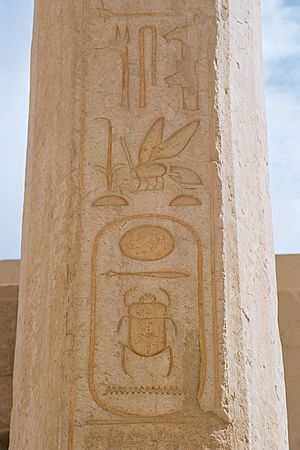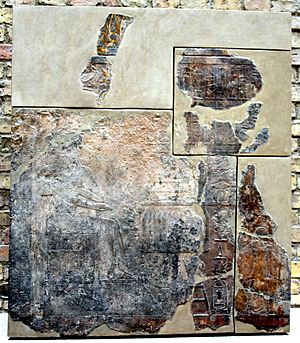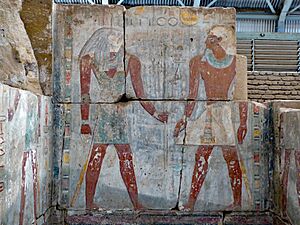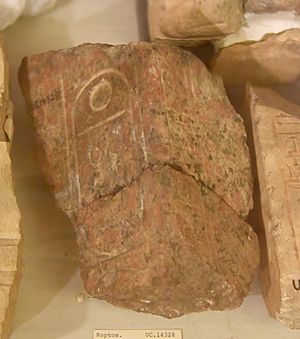Thutmose II facts for kids
Quick facts for kids Thutmose II |
|
|---|---|
| Thutmosis II Chebron, Chebros |
|
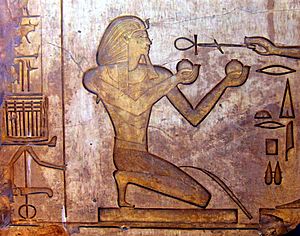
Relief of Thutmose II in the Karnak temple complex
|
|
| Pharaoh | |
| Reign | Either 13-14 or 2-3 regnal years: 1493–1480 BC (Low Chronology) 1513–1500 BC (High Chronology) 1513–1499 BC (Helck) 1493–1479 (Grimal) 1482–1480 BC (Cooney) 1482–1479 BC (Nadig) (18th Dynasty) |
| Predecessor | Thutmose I |
| Successor | Thutmose III |
| Consort | Hatshepsut, Iset |
| Children | Thutmose III, Neferure |
| Father | Thutmose I |
| Mother | Mutnofret |
| Born | c. 1492 BC (or 1502 BC) |
| Died | c. 1479 BC (aged approx. 13–23) |
| Burial | Tomb of Thutmose II, Western Wadis (original burial); Mummy found in the Deir el-Bahari royal cache (Theban Necropolis) [disputed] |
Thutmose II was an ancient Egyptian pharaoh, the fourth ruler of the Eighteenth Dynasty of Egypt. His reign is believed to have lasted either for about 13 years (from 1493 to 1479 BC) or a shorter period of just 3 years (from 1482 to 1479 BC). Not much is known about him, as he is often overshadowed by his famous family members. These include his father Thutmose I, his half-sister and wife Hatshepsut, and his son Thutmose III.
Thutmose II died before he turned 30. His tomb, located in the Western Wadis near the Valley of the Queens, was discovered in 2022 and officially confirmed as his in 2025. This tomb was built in an area prone to flooding, which caused damage over time. Because of this, his mummified body was moved long ago. Its final resting place was debated for a long time.
Thutmose II's Family and Background
The name Thutmose II is also spelled Thutmosis or Tuthmosis II. In older history books, it might appear as Thothmes. This name comes from ancient Egyptian, meaning "Thoth is born." Thoth was an important Egyptian god of wisdom and writing.
Thutmose II was the son of Thutmose I and a lesser wife named Mutnofret. Mutnofret was likely a daughter of an earlier pharaoh, Ahmose I. To strengthen his claim to the throne, Thutmose II married his royal half-sister, Hatshepsut. Since his mother was a princess and his father was not born into royalty, Thutmose II was probably born after his father became king. This means he was likely younger than Hatshepsut.
Some historians believe Thutmose II was quite young, perhaps in his early teens, when he became pharaoh. While he successfully stopped rebellions in Nubia and the Levant, and defeated a group of nomadic Bedouins, his generals led these battles, not Thutmose II himself. This suggests he might have been too young to lead the army in person.
Thutmose II had a daughter named Neferure with Hatshepsut. He also had a son, Thutmose III, with another wife named Iset.
Many archaeologists think that Hatshepsut was the true ruler behind the scenes during Thutmose II's reign. This is because the same types of policies were continued when she later ruled. Also, Hatshepsut claimed she was her father's chosen heir. She is shown with her husband, and sometimes alone, in carvings from a gateway at Karnak built during Thutmose II's time. Later, Hatshepsut became pharaoh herself. She even replaced her husband's name with her own on some parts of the gateway.
If Thutmose II was born after his father became king, he would have been in his early teens (if he had a short reign) or early twenties (if he had a longer reign) when he died.
How Long Did Thutmose II Rule?
Historians have different ideas about how long Thutmose II ruled. An ancient historian named Manetho said Thutmose II, whom he called "Chebron," ruled for 13 years. The name "Chebron" might come from Thutmose II's throne name, Aakheperenre.
Some Egyptologists believe he had a short reign of only about three years. This idea comes from the small number of records and artifacts found from his time. His highest known date is from his first year as king.
However, other scholars suggest a longer reign of 13 or 14 years. This is partly because he lived long enough to have two children, which might suggest a longer time on the throne.
Evidence for a Short Reign
An official named Ineni lived through Thutmose II's entire reign and into Hatshepsut's rule. Ineni's writings suggest Thutmose II ruled for a short time. Also, there are not many large monuments or records from Thutmose II's reign. This is partly because Hatshepsut later claimed many of his monuments as her own. Then, Thutmose III also changed names on some monuments.
One of Thutmose II's main monuments is a limestone gateway at Karnak. But even this was finished by his son, Thutmose III, which hints at a very short reign for Thutmose II. This gateway was later taken apart and its stones used in another building.
In 1987, a study looked at the number of scarab seals found from the reigns of Thutmose I, Thutmose II, and Hatshepsut. Scarabs are small and usually not changed, so they can give a good idea of how long a pharaoh ruled. Hatshepsut ruled for about 22 years. The study found far fewer scarabs for Thutmose II compared to Thutmose I and Hatshepsut. This suggests Thutmose II's reign was quite short, possibly around three years.
Historian Kara Cooney also supports a short reign, saying there were "hardly any temples with his name on them, no campaigns, no mortuary complex of any worth." She also notes that all of Thutmose II's known children were very young when he died. This suggests he died unexpectedly early.
Evidence for a Long Reign
Despite the arguments for a short reign, some still believe Thutmose II ruled for 13 or 14 years. The ancient official Ineni called Thutmose II a "hawk in the nest," which could mean he was a child when he became king. If he was a child, he would need a longer reign to grow up and have children.
Some scholars point to a possible date from Thutmose II's 18th year, found on a monument. However, this inscription is now usually thought to refer to Hatshepsut. Also, Hatshepsut celebrated a special festival called a Sed Jubilee in her 16th year as pharaoh. Some believe this celebration happened 30 years after her father Thutmose I died. This would leave a gap of 13 to 14 years for Thutmose II's reign between his father and Hatshepsut. However, Kara Cooney suggests Hatshepsut might have been celebrating 30 years of her father's dynasty, which would still fit a short reign for Thutmose II.
New archaeological discoveries at Karnak have found evidence of a large gateway and a festival court built by Thutmose II. Blocks from a chapel and a boat sanctuary built by him have also been found. These large building projects would have taken several years to complete, suggesting a longer reign. Also, some believe that Hatshepsut's famous temple at Deir el-Bahari was originally started by Thutmose II as his own burial temple.
These new findings suggest that Thutmose II was involved in more major building projects than previously thought. This supports the idea that his reign was closer to 13 years rather than just 3 years.
Military Actions
The Nubian Rebellion
In his first year as pharaoh, Thutmose II faced a rebellion in Kush, a region south of Egypt (modern-day Nubia). Rebellions often happened when a new Egyptian king took the throne. The Nubian state had been fully controlled by Thutmose I, Thutmose II's father. Rebels rose up, and Egyptian forces had to retreat into a fortress built by Thutmose I.
Because Thutmose II was quite young, he sent an army to Nubia instead of leading it himself. His father's military generals helped him easily crush this revolt. An ancient historian named Josephus wrote about this campaign, calling it the Ethiopic War.
A stone tablet from Aswan describes this event: Kush began to plan a revolt, causing trouble for the Egyptian king. Looting happened near the forts built by Thutmose I to stop rebellions from the tribes of Khent-hen-nefer. The chief of northern Kush started the fighting, along with two sons of the Kushite chief. The foreign lands were divided into five parts.
The Shasu Rebellion
In the Sinai region, Thutmose II also fought against the Shasu Bedouin. This campaign is mentioned by an official named Ahmose Pen-Nekhbet. Some scholars consider this a minor raid.
There is also a small record that mentions a campaign in Upper Retenu, which is in Syria. This campaign seems to have reached a place called Niy, where Thutmose I had hunted elephants after crossing the Euphrates River. This might mean the raid against the Shasu was just a stop on the way to Syria.
Important Records and Discoveries
There are not many monuments that clearly refer to Thutmose II. One reason is that his wife and successor, Hatshepsut, often put her name on monuments that Thutmose II had started. Another reason is that Thutmose III later changed names on some monuments to Thutmose II's.
Aswan Stela
At Aswan, a stone tablet called the "Aswan Stela" is dated to Thutmose II's first year as king. This is the earliest known date for his reign. It describes a rebellion in Upper Nubia.
Karnak Gateway
At Karnak, Thutmose II began building a limestone gateway in front of the Fourth Pylon at the Temple. This monument was not finished until Thutmose III's reign. Later, under Pharaoh Amenhotep III, the gateway was taken apart, and its stones were used in the foundation of another large structure called the Third Pylon.
Deir el-Bahari Stone Chest
In March 2020, archaeologists from Warsaw University found a treasure chest and a wooden box at the Egyptian site of Deir el-Bahari. The stone chest contained several items wrapped in linen. Inside, they found a goose skeleton, goose eggs, and what is believed to be an ibis egg, which had special meaning in ancient Egypt. A small wooden box was also found, which is thought to have the name of Pharaoh Thutmose II on it. The chest was about 40 cm long and looked like an ordinary stone block, making it well hidden.
Death and Burial
For a long time, the exact location of Thutmose II's tomb was unknown. Some thought it might have been KV42, but there was no royal burial equipment found there. In 2020, a team led by Polish archaeologist Andrzej Niwiński suggested a location near the Temple of Thutmose III and Temple of Hatshepsut, after finding a chest with Thutmose II's royal name.
In 2022, a joint Egyptian-British team discovered a new tomb in the Western Wadis, close to the Valley of the Kings. This tomb, called Wadi C-4, was full of rubble from flash floods, similar to another tomb called KV5. It was believed to have been used during the reigns of Hatshepsut and Thutmose III.
In 2025, Egyptian archaeologists officially announced that Wadi C-4 was indeed the tomb of Thutmose II. The tomb had many features typical of a king's burial, such as a blue-painted ceiling with yellow stars and parts of a religious text called the Amduat on the walls. They also found inscribed vessels and fragments of alabaster jars with the names of both Thutmose II and Hatshepsut, which helped confirm the tomb's owner. This was the first royal tomb found in the Valley of the Kings area since the discovery of Tomb of Tutankhamun in 1922.
The tomb was built in a spot beneath two waterfalls, which caused it to flood often during the wetter climate of the 18th dynasty. Because of this damage, Thutmose II's body was moved from his tomb long ago.
Thutmose II's Mummy
Thutmose II's mummy was found in the Deir el-Bahari cache in 1881. This secret hiding place contained the mummies of many important pharaohs from the 18th and 19th dynasties, including Ahmose I, Amenhotep I, Thutmose I, Thutmose III, Ramesses I, Seti I, Ramesses II, and Ramesses IX. A label on Thutmose II's mummy showed it had been re-wrapped during the Twenty-first Dynasty.
The mummy was unwrapped by Gaston Maspero in 1886. It looked very similar to the mummy of Thutmose I, suggesting they were indeed father and son. Thutmose II's body was badly damaged by ancient tomb robbers. His left arm was broken off at the shoulder, his forearm was separated at the elbow, and his right arm was cut off below the elbow. His chest and abdomen were also badly damaged, possibly by an axe. His right leg was also cut from his body. All these injuries happened after his death.
However, the body also showed signs that Thutmose II had a difficult life. Gaston Maspero noted that Thutmose II was "scarcely reached the age of thirty when he fell a victim to a disease." He also described the skin as rough in places, covered with scars, and the upper part of the skull as bald. The body was thin and shrunken, appearing to lack strength.
In 1991, a study using X-rays on royal mummies found that Thutmose II's mummy had facial features common among people from Nubia.
The mummy is known by the inventory number CG 61066. In April 2021, his mummy was moved from the Museum of Egyptian Antiquities to the National Museum of Egyptian Civilization as part of a grand event called the Pharaohs' Golden Parade.
The true identity of this mummy has been questioned recently. Piers Litherland, who helped discover Thutmose II's tomb in 2025, points out that the mummy from the Royal Cache was identified as Thutmose II mainly because a label on it said "Aa-en-re." Since Thutmose II's throne name was "Aa-kheper-en-re," this was used to identify him. However, Litherland notes that many mummies were mislabeled, so this evidence is not very strong. He also asks why, if this is truly Thutmose II's body, his burial items or fragments of them were never found with it.
See also
 In Spanish: Tutmosis II para niños
In Spanish: Tutmosis II para niños


